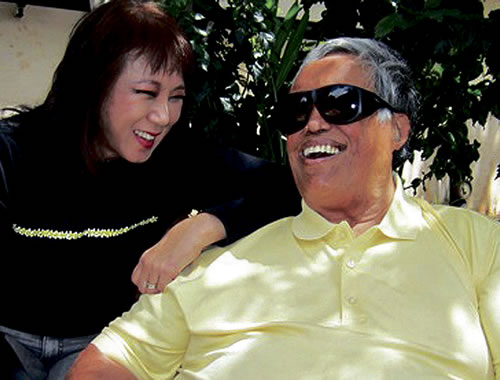Makia Malo & Pamela Young
As people and societies, we humans have the capabilities to be kind, compassionate and understanding on a daily basis. Yet we also have the ability to shun certain people, places and things, most times out of fear, pressure, resentment or just plain ignorance.Hawaii’s cultural history tells a story of this dilemma, and Makia Malo plays a pivotal role.
Malo – one of the last 18 living residents from Kalaupapa Leprosy Settlement on Molokai – in 1947 was taken from his Papakolea home and parents days before for turning 13. Like his best friend, kid brother PiliPili, and older sister Beka, Malo was diagnosed with what we now call Hansen’s disease. Between 1865 and 1969, Kalaupapa Leprosy Settlement was the location where Hawaii segregated the “diseased,” ostracizing innocent men, women and children by means of isolated quarantine.
For the majority of its history, Kalaupapa was a place where people went and never returned. Malo was not one of those people. He also had nothing to prove to those who sent him there.
He says he enjoyed his time on the Kalaupapa peninsula, the place with a storybook setting secluded behind the world’s tallest sea cliffs.
Malo went through physical and psychological perils, though, suffering from depression at times. Leprosy took its toll on his body, claiming portions of his fingers and toes. He has lost feeling in his hands and feet, as well as his vision.
Despite the hardships, Malo made a fulfilling life for himself, playing to his strengths. He had always been a storyteller, even before he knew he was one.
In the 1950s, with an effective leprosy treatment discovered, Malo spent much time back and forth between Kalaupapa and Hale Mohalu treatment center on Oahu. He began a steady education, gaining confidence as a writer and storyteller. He remembers first meeting master storyteller Jeff Gere.
“Jeff Gere came over and saw me outside. He said, ‘What’s your name?’ I said Elroy Malo.
“‘Mr. Malo, would you like to come tell stories with me?,’ he said. “‘Tell stories, I don’t know how to tell stories,’ I said. “‘Yes, you do, I heard you by your apartment,’ he says. “‘I wasn’t telling stories, I was only talking story,’ I said. “Jeff tells me that’s the same thing. Turned out to be just that. I started doing storytelling with him, going to different places around town,” says Malo, who was featured on MidWeek‘s cover June 4, 1997.
Malo spent decades telling stories and educating. He earned a degree in Hawaiian studies from UH-Manoa and travelled with Aunty Nona Beamer telling stories to schoolchildren.
Malo tells his stories with vivid description, emphasized by body gestures. He speaks about a life he knows. He recalls weekend trips to Laie with his family as a boy to gather taro for poi they would make before church on Sundays. He remembers impressing young servicemen, diving for money at Beauty Hole pond in Laie. He speaks about former wives, of love and pain. Malo has a unique fluctuation in his tone, spreading from bold and boisterous to high and surprised.
Malo tells stories of hunting in the Kalaupapa valleys with friends and swimming off the Kalaupapa shoreline, screaming back at the cliffs, using the echo as his compass back to shore.
With a creative imagination even today, Malo has written and told short stories, fables and poems. He combines his worlds – his childhood before being sent to Kalaupapa with what he discovered on the peninsula – and his re-integration into society afterward.
He traveled to Belgium and Rome for the canonization of Saint Damien in 2009. It was on that trip he bonded with KITV news anchor and MidWeek columnist Pamela Young.
Young, who grew up with a blind sister, felt completely comfortable around Malo. After asking her for a DVD copy of a news special she produced about coverage of Kalaupapa, Belgium and Rome to give to his niece Noe, Young, who graced MidWeek‘s cover Oct. 15, 2008, thought it would be more fitting for Malo’s niece to have the memoirs of her uncle’s storied life.
Malo and Young spent three years creating My Name Is Makia: A Memoir of Kalaupapa.
When asked who Makia Malo is to her, Young, with serenity in her eyes, says, “He is my friend; he is my teacher. He is a living treasure. He was a part of a dark part of Hawaii’s history and just living proof of how you can descend to hell and triumph. He has had a fantastic life, and I think a lot of people can learn from him and his life.”
To purchase the book or for more information, go to books-hawaii.net or visit your local bookstore.






